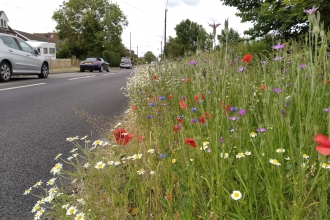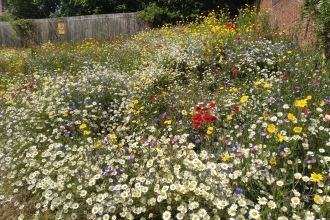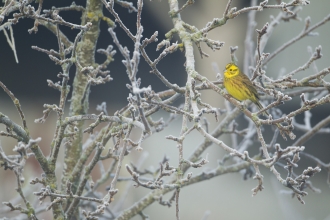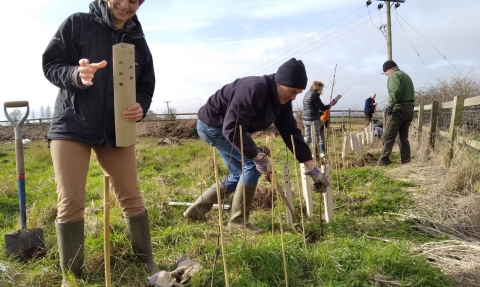
Planting saplings to become a hedge at Rectory Farm
Hedgerow Havens case study: a haven for wildlife at Rectory Farm
From 2018 to 2021, BBOWT's Hedgerow Havens project helped to conserve farmland wildlife around Aylesbury by working with landowners and parish councils. The project improved the quality of 'linear' habitats like hedgerows, field margins, ditches, road verges, watercourses, scrapes and ponds on farms and in villages. This is the story of the Hedgerow Havens Project’s work creating a haven for wildlife at Rectory Farm.
The Field at Rectory Farm in Weedon has an area of approximately one hectare. Prior to the current owners moving in, this area had been a horse paddock, grazed short in most years. In the years since, the field had been allowed to grow wild and by 2019 had become dominated by coarse grasses and cow parsley. During 2019, BBOWT’s Hedgerow Havens project worked alongside the owners of Rectory Farm to develop a plan to turn the area into a mini nature reserve.
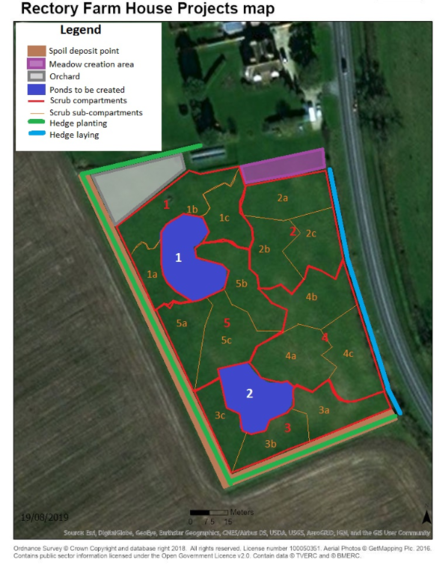
Hedgerow Havens Rectory Farm projects map showing how the team created a new one-hectare nature reserve. The field was previously rank grassland with an overgrown hedgerow but has now been converted to a mix of meadow, orchard, rotationally cut scrub, ponds new hedgerow and laid hedgerow.
As the map shows, the site has been designed to include two new ponds, earth banks, 260 metres of new hedgerow, a small wildflower meadow, a laid hedgerow and a mosaic of patchy scrub areas which will develop over the next 25 years. The owners have also created a small traditional orchard with local fruit varieties in the north western corner of the site.
Work started on site in December 2019 when local contractors laid the hedge adjoining the road. This hedge was largely filled with elm in the early stages of succumbing to Dutch Elm disease and was as such desperately in need of some rejuvenation. This was carried out through the process of ’mechanical hedgelaying’.
This rough and ready technique involves chainsaw operators making an incision at the base of the tree, whilst still leaving part of the live portion of the tree attached to the stump. The trees are then laid over with a digger. This technique has the benefit of being the fastest and cheapest way to lay a hedgerow and is in fact better for the wildlife that uses the hedge.
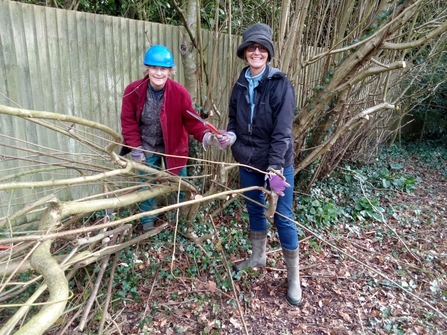
Volunteers laying hedge at Rectory Farm
Unlike traditional hedgelaying where much of the woody material so important for wildlife is removed, with this technique all the woody material is retained, creating a thick protective barrier for wildlife living within.
In January 2020 the digger and dumper rolled on site to carry out the creation of the two ponds and the earth bank. After a week of tracking back and forth across the site, two large ponds of around 400m2 each were ready and already filling with water, and 190m of earth bank had been created, all ready to be planted up with a new hedgerow. In the two years since, the ponds have been colonised by plants and insects. Herons have become a regular feature and swallows drink from the ponds in the summer.
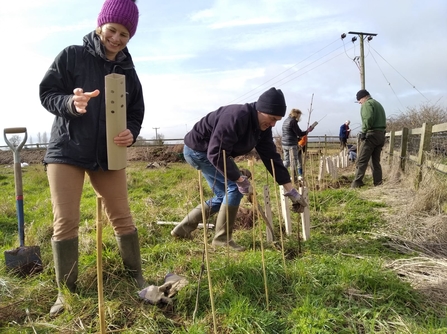
Planting saplings to become a hedge at Rectory Farm
In early 2020, several groups of volunteers from the local village of Weedon, the Hedgerow Havens Project and a corporate volunteer work party descended on the site to carry out the planting. After three days of work and numerous home baked cakes, 260m of new species-rich hedgerow had been planted. After another couple of days the wildflower meadow and the new earth banks had also been sown with wildflower seeds.
The seeds germinated and grew through the coronavirus lockdown and by June had bloomed, attracting numerous pollinators to the site. In the years since, these areas have now become grass dominated, providing shelter for wildlife beneath the hedgerow.
Work continued on site from late summer of 2020, with the Hedgerow Havens work party going on site to manage the newly-created meadow area in August 2020 and 2021. Hibernacula were also created by the work party which provided homes for amphibians and reptiles such as newts, frogs and toads which utilise the new ponds.
The site now continues to be managed by the owners and will continue to be looked after under their stewardship until 2044.

